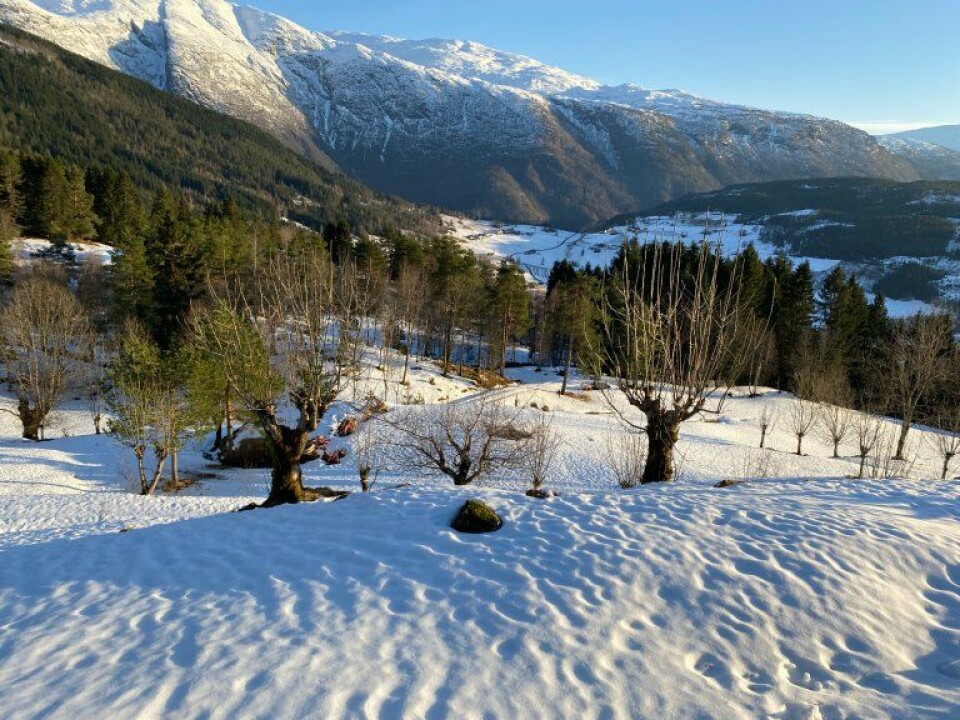THIS CONTENT IS BROUGHT TO YOU BY NIBIO - Norwegian Institute of Bioeconomy Research - read more

What is pollarding and why is it still practiced?
In the lush landscapes of Western Norway, pollarded trees bridge the past with modern environmental concerns.
Pollarding, a traditional practice of pruning trees to encourage new growth, mainly for fodder, has found a new lease of life. Particularly in Western Norway.
This is due to policy grants aimed at preserving cultural landscapes and enhancing biodiversity.
In a recent study, researchers delved into modern pollarding practices in Vestland county. The study combined in-depth interviews with surveys targeting pollarding farmers across the region.
Traditionally, pollarding provided additional fodder from the tree layer and made it possible to utilise resources from areas unsuitable for grazing and grass harvesting. The leaves were used as fodder and the branches were used for tools, poles, and firewood.
"Today, the economic returns of pollarding are too low to be worthwhile for farmers,” says Anna Birgitte Milford. She is a social economist and researcher at NIBIO.
The researchers wanted to find out what motivates the farmers to carry on using this practice. Do they pollard mainly due to the grants they receive for doing so, or are there other factors they consider more important?
The researchers have also been concerned with examining what ecosystem services pollarding contributes. These include bioresources, cultural benefits, and the preservation of biodiversity. Challenges related to pollarding were also addressed.
Part of the Norwegian cultural heritage

Through the interviews and survey, the researchers discovered that some farmers are motivated to pollard because of the erosion control and sheltering functions it provides to animals.
For most of the farmers, however, the ecosystem services obtained from pollarding are first and foremost related to cultural and aesthetic values.
“Many of the farmers we interviewed described how they appreciate a landscape with pollarded trees because of the cultural heritage it represents, and highlighted this as their main motivation to continue the practice,” says NIBIO-researcher Jørund Johansen who conducted most of the interviews.
As far as policies regarding pollarding is concerned, the researchers found that the farmers’ motivation for pollarding extended beyond mere economic incentives.
“The farmers who took part in the study see few disadvantages with pollarding. While the public grant serves as a welcome incentive, most of the farmers expressed a genuine commitment to continue pollarding irrespective of financial support,” Johansen says.

Pollarding enhances biodiversity
Old trees are extremely important for biodiversity. A pollarded tree has an increased likelihood of becoming old due to its aesthetic value and the tree’s physiology.
“Pollarded trees have a relatively small crown on a low and thick trunk, which makes the tree more robust against weather and wind. Additionally, pollarded trees often become hollow in the middle at a younger age than trees that are not managed. Hollow deciduous trees are a particularly valuable habitat for a variety of species,” says Fride Høistad Schei. She is a ecologist and researcher at NIBIO.
She adds that solitary trees in agricultural landscapes are important habitats for lichens, mosses, fungi, and insects. This fosters a rich tapestry of biodiversity.
"This was highlighted by several pollarding farmers as a significant motivating factor,” she says.
The study also revealed that several farmers who practise pollarding let the branches and twigs from the trees decay in heaps outside in the field. This increases the structural complexity of the landscape and provides nesting opportunities for animals.
“It's interesting to note that farmers do this against the advice of the County Governor who provides the pollarding grant, who rather recommends the pollarded area to be kept ‘nice and tidy’,” says Schei.

“This shows that in the formation of the pollarding policy, the aims of achieving both ecological and the aesthetic values are up against each other, something which is typical in the management of cultural landscapes.”
She adds that this is one of the topics the researchers have brought forth in discussions with representatives from the County Governor of Vestland, with a recommendation that changes be made to future guidelines.
Grant scheme should continue

Anna Birgitte Milford says that gaining insight into the aspects of modern pollarding practises can be useful when anticipating the future of pollarding, and to identify opportunities for enhancing the outcomes.
“Our results indicate that sharing information about the cultural heritage of pollarding and the benefits it may have on biodiversity, to farmers as well as to the general public, can be an important part of a strategy to uphold pollarding. Furthermore, it seems likely that without the economic incentives from the public grant, pollarding would to some extent continue, but perhaps more sporadically, and with less establishment of new pollarded trees,” she says.
The researchers believe that pollarding among farmers in Western Norway most likely requires the continuation of a grant scheme.
“To provide additional benefits to biodiversity, it could also be considered to revise the advice against piling branches in heaps instead of burning,” Schei concludes.
Reference:
Milford et al. “Historical signs in the landscape”: Ecosystem services, motivation and challenges of pollarding in Western Norway, Agroforestry Systems, 2024. DOI: 10.1007/s10457-024-00994-9

This content is paid for and presented by NIBIO - Norwegian Institute of Bioeconomy Research
This content is created by NIBIO's communication staff, who use this platform to communicate science and share results from research with the public. NIBIO is one of more than 80 owners of ScienceNorway.no. Read more here.
More content from NIBIO:
-
This colourful bird is thriving in Norway
-
Can drone-mounted tree planting replace manual tree planting?
-
Light traps can tell us more about nocturnal moths
-
Climate change and land use threaten Sámi reindeer husbandry
-
Researchers are now going to monitor carbon in forest and grassland soils
-
Nine facts about Norwegian agriculture




































